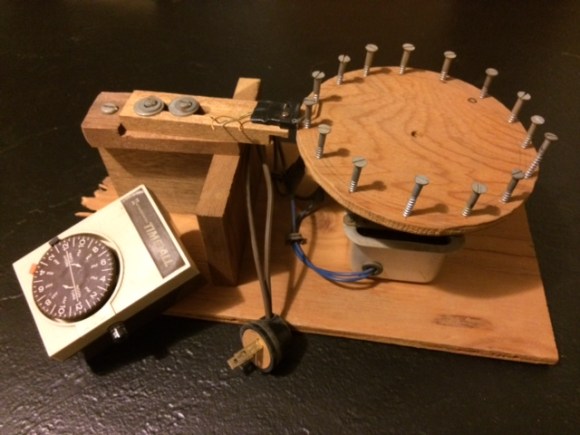
Let’s go back in time to the 1980’s, when shoulder pads were in vogue and the flux capacitor was first invented. New apartment housing was being built in [Vince’s] neighborhood, and he wanted some time-lapse footage of the construction. He had recently inherited an Elmo Super-8mm film camera that featured a remote control port and a speed selector. [Vince] figured he might be able to build his own intervalometer get some time-lapse footage of the construction. He was right.
An intervalometer is a device which counts intervals of time. These are commonly used in photography for taking time-lapse photos. You can configure the intervalometer to take a photo every few seconds, minutes, hours, etc. This photographic technique is great when you want see changes in a process that would normally be very subtle to the human eye. In this case, construction.
[Vince] started out by building his own remote control switch for the camera. A simple paddle-style momentary micro switch worked perfectly. After configuring the camera speed setting to “1”, he found that by pressing the remote button he could capture one single frame. Now all he needed was a way to press the button automatically every so often.
Being mechanically minded, [Vince] opted to build a mechanical solution rather than an electronic circuit. He first purchased a grandfather clock mechanism that had the biggest motor he could find. He then purchased a flange that allowed him to mount a custom-made wooden disk to the end of the minute hand’s axle. This resulted in a wheel that would spin exactly once per hour.
He then screwed 15 wood screws around the edge of the wheel, placed exactly 24 degrees apart. The custom paddle switch and motor assembly were mounted to each other in such a way that the wood screws would press the micro switch as they went by. The end result was a device that would automatically press the micro switch 15 times per hour.
[Vince] couldn’t stop there. This was the 1980’s. He wasn’t using a new-fangled digital camera. This camera used film and film costs money. There was no sense letting the camera run for 24 hours per day when the construction only happened for around 11 hours per day. He could have just manually turned the system on and off, but who wants to do that twice a day for weeks at a time? Instead, [Vince] hooked up the intervalometer’s power cord to an off-the-shelf 24 hour timer. The same kind of timer you might use on your Christmas lights or sprinkler system. He was able to configure the timer to run the intervalometer during the same hours as the construction. After three weeks [Vince] had the film developed. He was impressed with the results and went on to film the construction from several more locations.
Several decades later, [Vince] wanted to get that old film onto his computer. To accomplish that feat he fixed up his old Elmo 8mm projector and displayed the film onto a white sheet of paper. He then pointed his Canon ZR40 digital camcorder at the projected image and captured the footage live into Adobe Premiere. He was then able to encode the video into MP4 and upload it to the internet for the rest of us to enjoy.















I want to refute the flux capacitor statement, but there’s no information on Doc actually MADE the lateral-flux capacitor.
The flux capacitor was invented in 1955, but was later built in 1985.
Pedantic mode on!
The “flux capacitor” – a literary device and movie prop – was indeed invented in the 1980’s, by Zemeckis and/or Gale.
People practicing fisting might find it useful.
1980s!? This thing looks like it could be from the 1880s! My only question is where is the video?
He has it embedded on his website but that only works in Firefox and IE. If you are using chrome you should be able to view it here: http://www.codecooker.com/projects_photography/timeshift/video/timelapse-bennett.webm
work in Opera 12
Grassy ass (Google translate sucks too.)
back in 1980 I built Simon Carrol’s first intervelometer rig, it was a 6502, 6522 VIA, 2716 EPROM and 2K of RAM.
Time was kept with the VIA, which also controlled a stepper motor driving an ancient (back then) 35mm cine camera, a 4 digit 7 segment display, a couple of LEDs and buttons.
You could set frame interval and exposure duration.
Having a spare I/O pin let us control a Nikon 35mm SLR as well on it’s own time loop.
The rig was built to film Halley’s Comet
I haven’t seen him for ages, but keep seeing his name in the credits for documentaries
http://www.simoncarroll.com/
Back in 1980 I would have nailed my winky to a burning building or be seen driving a ford before I built a mechanical horror like this!
I believe this is the third time that Vince has been featured, although I could be wrong. I do know that his son has been on twice.
It’s interesting to note that the pace of construction has not changed appreciably in the intervening years.
But the size of the construction project has changed significantly?